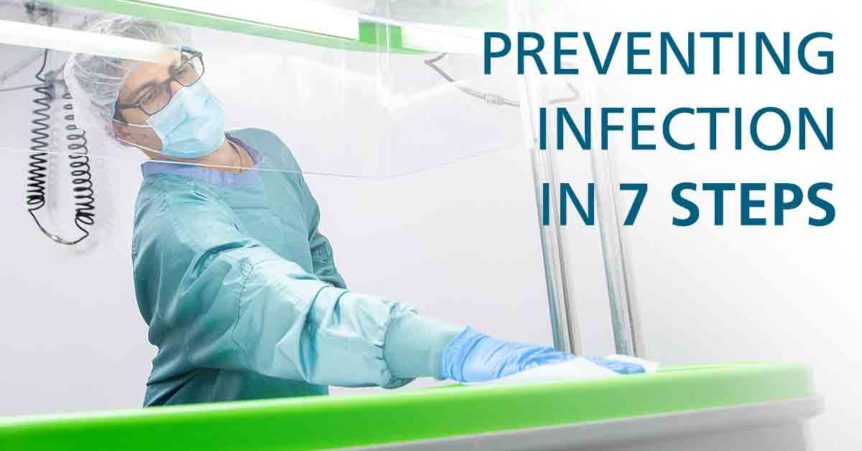In lab animal research facilities, protocols are second nature. You wouldn’t simply figure out how to conduct an important experiment as you go: you have approved procedures in place to ensure that everything goes as planned. However, it can be easy to think of cleaning and disinfection as an afterthought and forget how important is to have a solid protocol in place and staff trained to ensure they understand the process to be followed. Animal infections from viruses, bacteria, and fungi can wreak havoc on your research, but the threat doesn’t end there – other pathogens such as Influenza, Norovirus, and Coronaviruses can lead to staff shortages due to illness, halting critical projects. By investing in a rigorous cleaning and disinfection protocol, you’re protecting the integrity of your research from the ever-present threat of infection to animals or humans.
Step 1: Clarify roles and responsibilities within your facility.
Cleaning and disinfection is not “someone else’s job” – everyone on your team has a role to play in making sure that cleaning and disinfection is done properly. This means making sure that everyone understands the protocols used for cleaning and disinfection, and who is accountable for each area throughout the facility. Creating a ‘working group’ or committee for infection prevention can be a great way to ensure accountability and prevent important steps from being missed.
Step 2: Identify and designate levels of biosecurity risk based on the different areas in your facility.
To start building out your cleaning and disinfection protocol, make a list of the surfaces throughout your facility that will need to be cleaned and disinfected, and how frequently this will need to happen. The frequency of disinfection will depend on the level of infection risk associated with the surface: high-risk surfaces such as animal housing units will likely need to be disinfected daily, while lower-risk surfaces such as hallways and office areas may only need occasional disinfection. Using signage or colour codes to designate levels of infection risk throughout the facility can help guide those responsible for cleaning and disinfection, and prevent cross-contamination.
Step 3: Consider the mode of transmission for possible pathogens and break the cycle of transmission.
Understanding how a given pathogen spreads from one host to the next can help you stop the cycle of transmission. For pathogens spread between direct contact between animals, keeping infected animals isolated is an important measure. When dealing with airborne pathogens, maintaining adequate air circulation, providing space between animals is key, along with avoiding spray applications (particularly at high temperatures) when disinfecting, to limit the aerosolization of pathogens. For pathogens that can be spread through contaminated surfaces, also known as fomites, regular cleaning, and disinfection of surfaces and objects that animals contact is essential.
Step 4: Choose the right products for your facility’s cleaning and disinfection
Choosing the right products for cleaning and disinfection can feel overwhelming with all the products on the market, but there are a few questions you can ask to guide your selection:
- Is it a one-step cleaner-disinfectant?
- One-step products with built-in detergents offer the advantage of combining cleaning and disinfection into a single step, eliminating the need to pre-clean using a separate detergent product.
- Does it have a positive safety profile?
- Ideally, look for a product that is non-toxic and non-irritating to eyes and skin when used as directed. The product’s label and Safety Data Sheet (SDS) will alert you to any hazards to look out for when using the disinfectant.
- Is it effective against pathogens of concern in a realistic contact time?
- The disinfectant you choose should be effective against a broad spectrum of pathogens that are relevant to your facility. It should also be capable of killing pathogens in a realistic period of time, also known as the product’s contact time.
- Is it available in convenient formats?
- While a lot of disinfectants are offered in concentrate form, some may have ready-to-use liquids as well as disposable wipes. While concentrates are ideal for covering large surface areas such as floors, ready-to-use sprays and wipes can be used to disinfect high-touch surfaces quickly and easily throughout the day. Some disinfectants require mixing multiple parts and additional time to activate the solution, which can slow down the process significantly.
Step 5: Train your entire staff on the proper use of the specific products you choose for cleaning and disinfection
Make sure your team is trained on the “2 Ps” of disinfection – product and process. In terms of product, this includes all aspects of how to use your disinfectant, including whether it needs to be diluted (and if so, what ratios are required), and whether personal protective equipment is needed to prepare and use the product. Also, ensure that your team is aware of the contact time of the disinfectant, as well as how the product should be properly stored, and shelf life once prepared.
Step 6: Make the cleaning and disinfectant product you choose readily accessible along with any other required tools.
Having tools accessible makes cleaning and disinfection easier, and reduces unnecessary movement between areas, protecting against cross-contamination.
Step 7: Set up routine quality-control measures and compliance monitoring.
Having a few basic quality control measures can go a long way in ensuring that everyone is accountable for the success of the protocol. Using logs is a great way to keep track of whether your protocol is being followed. Labels for disinfectant materials can help your team keep track of important information, such as the expiry date of the solution. Additionally, having test strips on hand to validate dilution is an important part of developing a preventative maintenance program for automated dilution systems.



